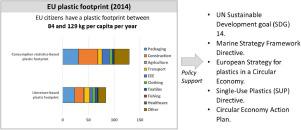Resources, Conservation and Recycling ( IF 11.2 ) Pub Date : 2021-12-04 , DOI: 10.1016/j.resconrec.2021.106086 Andrea Martino Amadei 1 , Esther Sanyé-Mengual 2 , Serenella Sala 2

|
Despite plastic being one of the most used materials globally, information about plastic flows in value chains is generally lacking. The present study aims at estimating the European Union (EU) plastic footprint (including production and consumption flows) by combining different approaches, as well as at estimating marine littering potentials. Plastic flow estimates build on a literature review of studies on material flows analysis to gather available data. The review highlights the lack of complete and homogeneous estimates of EU plastic production and consumption, as well as detailed figures for specific sectors (e.g., fishing, healthcare, electrical and electronic equipment). Data retrieved from literature were compared with estimates based on consumption statistics (i.e., PRODCOM database). Estimates for 2014 based on literature equals to 84 kg/person, whilst results derived from PRODCOM for the 2014 equals to 129 kg/person (with an average of 112 kg/person for the period 2010–2019). Packaging contributes to 27.9% of the overall footprint in the case of the literature-based approach (23.6% in the case of PRODCOM results), which is dominated by three polymers (LDPE, PP and PET). Concerning the marine litter potential, beach litter rates -based on EU beach litter observations and plastic statistics- were in the order of 10000 part per million of the consumed plastic.. This study unveiled that methodological improvements in estimates of the EU plastic footprint together with plastic littering potential, as well as further data gathering, are fundamental steps for fulfilling the EU ambitions to assess and reduce the environmental impacts of plastics.
中文翻译:

欧盟塑料足迹建模:探索数据来源和垃圾处理潜力
尽管塑料是全球最常用的材料之一,但普遍缺乏有关塑料在价值链中流动的信息。本研究旨在通过结合不同的方法来估算欧盟 (EU) 的塑料足迹(包括生产和消费流量),以及估算海洋垃圾的潜力。塑性流动估计建立在对材料流动分析研究的文献回顾的基础上,以收集可用数据。审查强调缺乏对欧盟塑料生产和消费的完整和同质估计,以及特定部门(例如渔业、医疗保健、电气和电子设备)的详细数据。从文献中检索到的数据与基于消费统计(即 PRODCOM 数据库)的估计值进行了比较。根据文献估计 2014 年为 84 公斤/人,而来自 PRODCOM 的 2014 年结果为 129 公斤/人(2010-2019 年期间平均为 112 公斤/人)。在基于文献的方法的情况下,包装占总足迹的 27.9%(在 PRODCOM 结果的情况下为 23.6%),主要由三种聚合物(LDPE、PP 和 PET)主导。关于海洋垃圾的潜力,基于欧盟海滩垃圾观察和塑料统计数据的海滩垃圾率约为消耗塑料的百万分之 10000。这项研究揭示了欧盟塑料足迹估计方法上的改进以及塑料垃圾的潜力,以及进一步的数据收集,











































 京公网安备 11010802027423号
京公网安备 11010802027423号